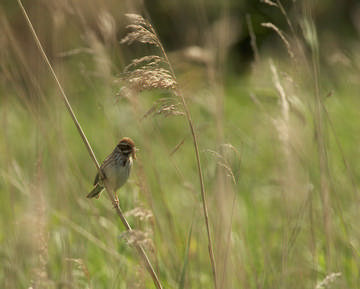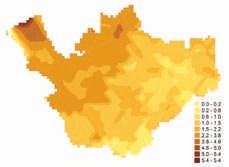
Reed Bunting © Richard Steel
The rapid decline in breeding numbers has put Reed Bunting on the Red List of species of conservation concern, with a national and local BAP to support action for its recovery. The national population index for Reed Bunting crashed to reach a low point in 1984 that was 57% down on their peak just a decade earlier in 1975; the Cheshire and Wirral picture may have been worse, since the fall in northern Britain was greater than in southern areas (Peach et al 1999). Since then, the national index has fluctuated within quite a narrow range and the 2004 figure is little different from that of twenty years before. Thus, the population was falling throughout the period of our First Atlas, and the large decrease (169 lost, 54 gained) in occupied tetrads shown in the ‘change’ map is probably mainly in tetrads surveyed in the early years of our 1978-84 First Atlas survey. This drop is widespread and scattered throughout the county but includes a major loss from most of the Wirral peninsula. It is still, however, a common bird of the damp, scrubby areas in the Mersey valley, and Reed Bunting is perhaps the characteristic species of the marl pit ponds across much of agricultural Cheshire; the only areas showing more than the odd gains since our First Atlas are in the south-west of the county.
Demographic analyses suggest that the national decline was driven by decreasing over-winter survival rates, particularly for the inexperienced first-year birds, probably because of reduced availability of small seeds on farmland (Peach et al. 1999). The breeding decline was as severe along waterways as on farmland, and deterioration of the Reed Bunting’s characteristic wetland habitats may have had a serious effect, through loss of small ponds, unsympathetic river engineering and the encroachment of scrub and carr. In other parts of Britain, Reed Buntings have compensated by moving to breed into fields of this crop: farmland densities are four times higher in oilseed rape than in cereals or setaside (Gruar et al 2006). This is not likely to have had much effect in Cheshire and Wirral, however, with the relatively low area of this crop.

Reed Bunting abundance.
Breeding Reed Buntings occupied a very wide range of habitats. Most contained water or reedbed, but a significant fraction of birds belie the species’ name. During the middle of the 20th century the species had spread out to occupy some dry habitats, although these are probably sub-optimal and much of the population decline seems to have been in these drier areas. Even in apparently favourable habitat, however, there have been waning numbers. This species has been included in most years of the mid-May Woolston warbler census; counts have dropped dramatically from a mean of 103 singing males in the years 1983-89, to 78 males in 1994-97 and a mean of only 36 singing males during the three years of this Atlas. The unmanaged progression from open scrub towards a drier woodland has presumably been inimical to this species. It has also been noticeable across the county that the species has extended its breeding season, with some birds singing into August, probably driven by the poor success of early nests to prolong their season with further attempts. Fieldworkers confirmed breeding in 40% of the tetrads, mostly by seeing adults with a beak full of grubs, the observers’ attention probably being drawn by the birds’ insistent anxiety calls. Adults feed themselves on small seeds all year round, but have to find the protein-rich invertebrates for their chicks; it may be a reduction in insects that has cut Reed Bunting breeding numbers, especially in drier habitats.
The BTO analysis of 2004-05 BBS data puts the breeding population of Cheshire and Wirral as 4,410 birds (3,930-4,930), corresponding to an average of about 16 birds per tetrad with confirmed or probable breeding, or 10 birds per tetrad in which the species was recorded. The abundance map, although distorted for much of Wirral, shows that the main density of Reed Buntings is along the Mersey valley, where most of their ideal habitat is to be found.
Sponsored by Robin Hart

